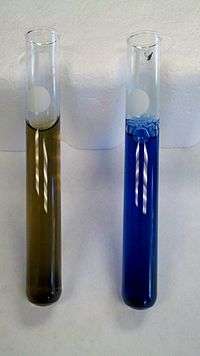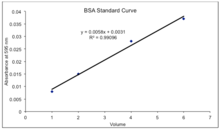Bradford protein assay
The Bradford protein assay is a spectroscopic analytical procedure used to measure the concentration of protein in a solution. It is subjective, i.e., dependent on the amino acid composition of the measured protein. The Bradford protein assay was developed by Marion M. Bradford.
Principle

The Bradford assay, a colorimetric protein assay, is based on an absorbance shift of the dye Coomassie Brilliant Blue G-250. Under acidic conditions the red form of the dye is converted into its bluer form, binding to the protein being assayed. During the formation of this complex, two types of bond interactions take place: van der Waals forces and ionic forces. The red form of Coomassie dye first donates its free electron to the ionizable groups on the protein, which causes a disruption of the protein's native state, consequently exposing its hydrophobic pockets. These pockets in the protein's tertiary structure bind non-covalently to the non-polar region of the dye via the first bond interaction (van der Waals forces) which position the positive amine groups in proximity with the negative charge of the dye. The bond is further strengthened by the second bond interaction between the two, the ionic interaction. The binding of the protein stabilizes the blue form of the Coomassie dye; thus the amount of the complex present in solution is a measure for the protein concentration, and can be estimated by use of an absorbance reading.
The cationic (unbound) form is green / red and has an absorption spectrum maximum historically held to be at 465 nm. The anionic (bound) form of the dye has an absorption spectrum maximum historically held to be at 595 nm. The increase of absorbance at 595 nm is proportional to the amount of bound dye, and thus to the amount (concentration) of protein present in the sample.
Unlike other protein assays, the Bradford protein assay is less susceptible to interference by various chemicals that may be present in protein samples. An exception of note is elevated concentrations of detergent. Sodium dodecyl sulfate (SDS), a common detergent, may be found in protein extracts because it is used to lyse cells by disrupting the membrane lipid bilayer. While other detergents interfere with the assay at high concentration, the interference caused by SDS is of two different modes, and each occurs at a different concentration. When SDS concentrations are below critical micelle concentration (known as CMC, 0.00333%W/V to 0.0667%) in a Coomassie dye solution, the detergent tends to bind strongly with the protein, inhibiting the protein binding sites for the dye reagent. This can cause underestimations of protein concentration in solution. When SDS concentrations are above CMC, the detergent associates strongly with the green form of the Coomassie dye, causing the equilibrium to shift, thereby producing more of the blue form. This causes an increase in the absorbance at 595 nm independent of protein presence.
Other interference may come from the buffer used when preparing the protein sample. A high concentration of buffer will cause an overestimated protein concentration due to depletion of free protons from the solution by conjugate base from the buffer. This will not be a problem if a low concentration of protein (subsequently the buffer) is used.
Advantages
The procedure for Bradford protein assay is very easy and simple to follow. It is done in one step where the Bradford reagent is added to a test tube along with the sample. After mixing well, the mixture almost immediately changes to a blue color and the absorbance can be read at 595 nm using a spectrophotometer; an easily accessible machine.
This assay is one of the fastest assays performed on proteins.[1] The total time it takes to set up and complete the assay is under 30 minutes.[2] The entire experiment is done at room temperature.
The Bradford protein assay can measure protein quantities as little as 1 to 20 μg.[3] It is an extremely sensitive technique.
The dye reagent is a stable ready to use product prepared in phosphoric acid. It can remain at room temperature for up to 2 weeks before it starts to degrade.
Protein samples usually contains salts, solvents, buffers, preservatives, and metal chelating agents. Using Bradford can be advantageous against these molecules because they are compatible to each other and will not interfere.[4]
The linear graph acquired from the assay (absorbance versus protein concentration in μg/mL) can be easily extrapolated to determine the concentration of proteins by using the slope of the line.
Disadvantages
The Bradford assay is linear over a short range, typically from 0 µg/mL to 2000 µg/mL, often making dilutions of a sample necessary before analysis. In making these dilutions, error in one dilution is compounded in further dilutions resulting in a linear relationship that may not always be accurate.
It is also inhibited by the presence of detergents, although this problem can be alleviated by the addition of cyclodextrins to the assay mixture.[5]
Much of the non-linearity stems from the equilibrium between two different forms of the dye which is perturbed by adding the protein. The Bradford assay linearizes by measuring the ratio of the absorbances, 595 over 450 nm. This modified Bradford assay is approximately 10 times more sensitive than the conventional one. (Zor & Selinger, 1995)
Sample Bradford procedure
Materials
- Lyophilized bovine plasma gamma globulin
- Coomassie Brilliant Blue 1
- 0.15 M NaCl
- Spectrophotometer and tubes
- Micropipettes
Procedure (Standard Assay, 20-150 µg protein; 200-1500 µg/mL)
- Prepare a series of protein standards diluted with 0.15 M NaCl to final concentrations of 0 (blank = NaCl only), 250, 500, 750 and 1500 µg/mL. Also prepare serial dilutions of the unknown sample to be measured.
- Add 100 µL of each of the above to a separate test tube (or spectrophotometer tube if using a Spec 20).
- Add 5.0 mL of Coomassie Blue to each tube and mix by vortex, or inversion.
- Adjust the spectrophotometer to a wavelength of 595 nm, and blank using the tube which contains no protein.
- Wait 5 minutes and read each of the standards and each of the samples at 595 nm wavelength.
- Plot the absorbance of the standards vs. their concentration. Compute the extinction coefficient and calculate the concentrations of the unknown samples.
Procedure (Micro Assay, 1-10 µg protein/mL)
- Prepare standard concentrations of protein of 1, 5, 7.5 and 10 µg/mL. Prepare a blank of NaCl only. Prepare a series of sample dilutions.
- Add 100 µL of each of the above to separate tubes (use microcentrifuge tubes) and add 1.0 mL of Coomassie Blue to each tube.
- Turn on and adjust a spectrophotometer to a wavelength of 595 nm, and blank the spectrophotometer using 1.5 mL cuvettes.
- Wait 2 minutes and read the absorbance of each standard and sample at 595 nm.
- Plot the absorbance of the standards vs. their concentration. Compute the extinction coefficient and calculate the concentrations of the unknown samples.
Using data obtained to find concentration of unknown
In summary, in order to find a standard curve, one must use varying concentrations of BSA in order to create a standard curve with concentration plotted on the x-axis and absorbance plotted on the y-axis. This standard curve is then used to determine the concentration of the unknown protein. The following elaborates on how one goes from the standard curve to the concentration of the unknown.
First, add a line of best fit, or Linear regression and display the equation on the chart. Ideally, the R2 value will be as close to 1 as possible. R represents the sum of the square values of the fit subtracted from each data point. Therefore, if R2 is much less than one, consider redoing the experiment to get one with more reliable data. [6]

The equation displayed on the chart gives a means for calculating the absorbance and therefore concentration of the unknown samples. In Graph 1, x is concentration and y is absorbance, so one must rearrange the equation to solve for x and enter the absorbance of the measured unknown. [7] It is likely that the unknown will have absorbance numbers outside the range of the standard. These should not be included calculations, as the equation given cannot apply to numbers outside of its limitations. In a large scale, one must compute the extinction coefficient using the Beer-Lambert Law A=εLC in which A is the measured absorbance, ε is the slope of the standard curve, L is the length of the cuvette, and C is the concentration being determined. [8] In a micro scale, a cuvette may not be used and therefore one only has to rearrange to solve for x.

In order to attain a concentration that makes sense with the data, the dilutions, concentrations, and units of the unknown must be normalized (Table 1). To do this, one must divide concentration by volume of protein in order to normalize concentration and multiply by amount diluted to correct for any dilution made in the protein before performing the assay.
Alternative assays
Alternative protein assays include:
- Ultraviolet–visible spectroscopy
- Biuret protein assay
- Lowry protein assay
- BCA protein assay
- Amido black protein assay
References
- ↑ Okutucu, Burcu; Dınçer, Ayşşe; Habib, Ömer; Zıhnıoglu, Figen (2007-08-01). "Comparison of five methods for determination of total plasma protein concentration". Journal of Biochemical and Biophysical Methods. 70 (5): 709–711. doi:10.1016/j.jbbm.2007.05.009.
- ↑ "Protein Assay Technical Handbook" (PDF).
- ↑ "4.5. Determination of protein concentration". elte.prompt.hu. Retrieved 2016-05-19.
- ↑ Ninfa, Alexander J. (2010). Fundamental Laboratory Approaches for Biochemistry and Biotechnology. Wiley. pp. 117–118. ISBN 978-0470087664.
- ↑ Rabilloud, Thierry. "A single step protein assay that is both detergent and reducer compatible: The cydex blue assay.". Electrophoresis. 37 (20): 2595–2601. arXiv:1610.07373
 . doi:10.1002/elps.201600270. PMID 27445231.
. doi:10.1002/elps.201600270. PMID 27445231. - ↑ Albright, Brian (2009). Mathematical Modeling with Excel. p. 60. ISBN 978-0763765668.
- ↑ Stephenson, Frank Harold (2003). Calculations for molecular biology and biotechnology: a guide to mathematics in the laboratory. p. 252. ISBN 0126657513.
- ↑ Ibanez, Jorge G. (2007). Environmental chemistry: fundamentals. p. 60. ISBN 0387260617.
Further reading
- Bradford, M.M. (1976), "Rapid and sensitive method for the quantitation of microgram quantities of protein utilizing the principle of protein-dye binding", Anal. Biochem., 72: 248–254, doi:10.1016/0003-2697(76)90527-3, PMID 942051
- Zor, T.; Selinger, Z. (1996), "Linearization of the Bradford protein assay increases its sensitivity: theoretical and experimental studies", Anal. Biochem., 236: 302–308, doi:10.1006/abio.1996.0171, PMID 8660509
- Noble, J.E.; Bailey, M.J.A. (2009), "Quantitation of Protein", Methods Enzymol., 463: 73–95, doi:10.1016/S0076-6879(09)63008-1
- Albright, Brian (2009), Mathematical Modeling with Excel, p. 60, ISBN 978-0763765668
- Stephenson, Frank Harold (2003), Calculations for molecular biology and biotechnology: a guide to mathematics in the laboratory, p. 252, ISBN 0126657513
- Dennison, Clive (2003), "A guide to protein isolation", Focus on structural biology, 3: 39, ISBN 1402012241
- Ibanez, Jorge G. (2007), Environmental chemistry: fundamentals, p. 60, ISBN 0387260617